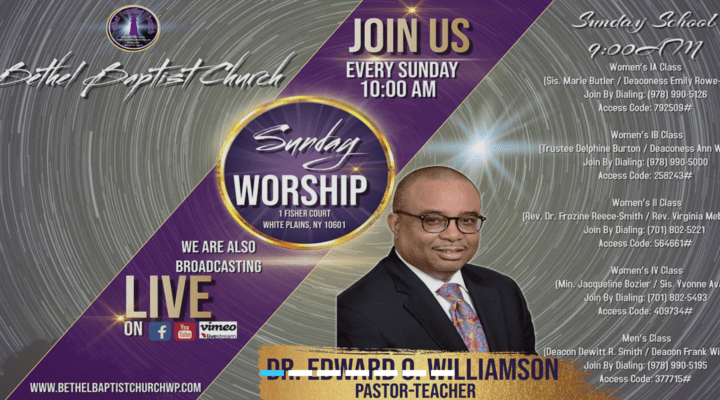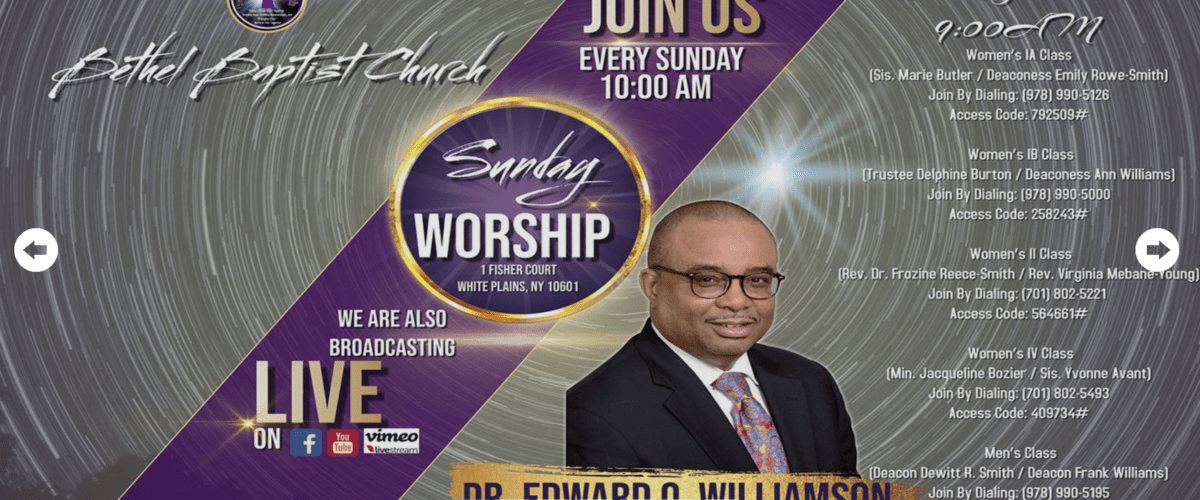There’s nothing new about people attending church in their living rooms and kitchens. Since the earliest days of television, there has been a symbiotic relationship between preachers and viewers. But what once was a sometimes-dubious bond — with televangelists offering prayers in exchange for donations — has given way to full-fledged online church membership. In some cases, this began before COVID-19, but more congregations are ramping up efforts during the pandemic to attract and nurture online members.
A Pew Research Center survey of church activities during the pandemic, published in August, seems to indicate that virtual church attendance has taken hold in the United States. Among regular worshippers, one-third say they have attended religious services in person while nearly three-quarters have watched virtually. Half of regular worshippers have replaced in-person attendance with virtual services, and just over half of adults who have recently watched virtual services had not done so before the outbreak.
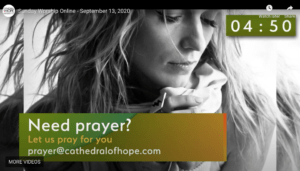
Screenshot of a pre-service slide from Cathedral of Hope.
Among churches with longstanding long-distance members is Cathedral of Hope in Dallas. Established as a Metropolitan Community Church in 1970 and then joining the United Church of Christ in 2006, Cathedral of Hope has a 50-year history as an affirming place of worship for the LGBTQ community, and that has attracted worshipers from throughout the United States and beyond. The church reports a formal membership of about 4,500, with several hundred of those being online members.
“For a long time, Cathedral of Hope has been engaged in distribution of worship services, whether by broadcast on TV and now online,” said Andria M. Davis, associate pastor. “So the question we’ve really been asking ourselves is: Is that enough? And for us for a long time, it was.”
When the pandemic pushed entire congregations into the new world of virtual worship, it also opened the doors for virtual gatherings of small groups for Bible study and other activities. The result is that once-anonymous online worshipers are now gaining names and faces through Zoom and other meeting platforms.
“Every week we have folks who worship with us who are from all over the world, and so we’re trying to mobilize people where they are,” Davis said. “That means pathways to small groups that meet in virtual contexts. Because of the pandemic, it’s been much easier to make that jump.”
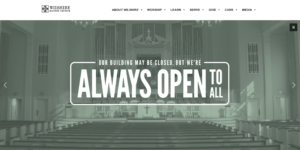
Screenshot from homepage of Wilshire Baptist Church.
On the other side of Dallas, Wilshire Baptist Church had just one virtual member — in Brazil — before the pandemic, but has since added six more in far-flung locations such as Mexico, Oregon, North Carolina and Massachusetts. Others have joined the church from as far out as 30 to 40 miles, and unknown numbers are visiting online from unknown locations.
“The biggest issue is how to find them, and the biggest worry is how to keep them engaged,” said Carolyn Murray, coordinator of congregational life.
In addition to streaming its worship service live for nine years now, Wilshire has offered a livestream adult Sunday school class since 2015. A second class will go live when the pandemic ends, but all Bible study is virtual through Zoom or Facebook for now.
“We are also connecting the virtual members with a first-year pastoral resident as a source of pastoral care,” Murray said, referring to the church’s longstanding Pathways to Ministry program in which seminary graduates learn and serve in the congregation for two years.
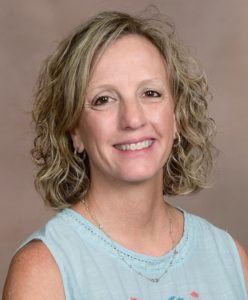
Carolyn Murray
Murray said Wilshire considers virtual members to be “full” members, and with that has come a question of what to do when the church votes on a matter — such as with votes in recent years about inclusion and diversity and acceptance of forms of baptism other than immersion. While virtual members are fully eligible to vote, the church’s bylaws imply that voting must be done in person, and indeed that has been the case in the past.
Cathedral of Hope has grappled with church polity too, but engagement and mission are the priorities, Davis said.
“Frankly, while we do have processes for that — we have proxy voting, we have absentee voting, that kind of thing — that’s not the point,” she said. “It’s all about how do we engage with folks and create a home for people, a faith home, a church home, a community that they can identify with and be on this spiritual faith journey with? That’s No. 1, and so we set the polity question aside.”
Long-distance history
When it comes to long-distance reach, few churches have more experience than Marble Collegiate Church in New York City, founded in 1628 and gaining an international following during the pastorate of Norman Vincent Peale from 1932 to 1984. Peale’s books and radio programs brought many to the church while on vacation or business in New York and helped generate a strong following through the mail. During the 1964-65 New York World’s Fair, the church deployed the then-new technology of closed-circuit television to accommodate overflow crowds for worship. While that experience did not lead directly to the growth of online membership, it gave the church some experience with distant congregants.
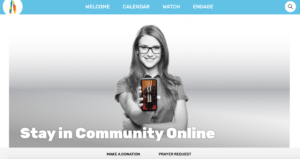
Screenshot from Marble Collegiate website
Kim Sebastian-Ryan, Marble’s director of membership and connecting, said the church began working on its online presence 12 years ago. It began with livestreaming Sunday and Wednesday worship services and then adding Bible studies and affinity groups. The new online offerings were embraced by members who had moved away but wanted to stay connected and by others who found their way to Marble on their own and wanted a way to connect from afar. Through the years they’ve built on that, and now with COVID they’ve opened up their call links so they can have 100 or more callers for different gatherings and can use breakout rooms to create smaller groups.
Today, Marble Collegiate has some 2,000 members, but it does not have a firm number for how many of those are virtual.
“We make no distinction in membership,” Sebastian-Ryan explained. “Whether you are worshipping online or are here, we want you to be a member of our Marble family.”
Virtual missions and service
While technology has bridged the gap between in-person and online worship and Bible study, the last frontier for online church membership may be in missions activities, where members come out of the pews and serve each other and their community.
“We certainly have members who are plugging in online that are committee members online and are board members online,” said Sebastian-Ryan at Marble Collegiate. “At the committee level, there is always involvement in the planning (of missions efforts). But in the actual doing level, we’re working on that. It’s always a work in progress, and we acknowledge that with everybody.”
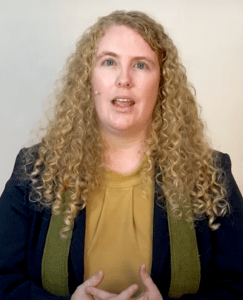
Adria Davis in a recent online worship video from Cathedral of Hope.
Davis said Cathedral of Hope is addressing that by asking outreach groups to develop and design ministries that can be transplanted to members wherever they are. An example is “Taste of Hope,” a ministry where volunteers meet in private homes twice a month to prepare hot meals for delivery to food insecure and homeless people in Dallas.
“They’ve designed their model so that it can be replicated wherever people are — wherever these home groups are. That can be in Dallas, it can be in Fort Worth, it can be in Austin, in the middle of Wyoming somewhere, it can be in the middle of Australia or England, where we have communities,” she said. “Using that as a model is how we’re going to continue to carry this forward through this pandemic time and then into whatever this new normal may be.”
Another question that looms for any church wanting to nurture and maintain an online membership presence is how to keep online members logging in, including when the church doors open again.
“How do we honor their experience and keep them engaged in the life of the church when we shift gears?” Davis asked.
South Main Baptist Church in Houston has seen an uptick in people around the country who are participating in discipleship groups via Zoom in addition to attending online worship, according to Matt Walton, minister for discipleship.

Matt Walton leading in online worship at South Main Baptist Church.
“These were folks who pre-pandemic connected to our live virtual broadcast of worship and during the pandemic (with all discipleship groups meeting virtually), joined our local groups which are now online,” he said. “This has caused us to begin considering how we might continue virtual connection alongside groups meeting physically on our campus when we are able to do so again.”
Marble Collegiate’s Sebastian-Ryan said that when online members depart, it’s for the same reasons that local members leave: major life changes and getting involved in a local church.
“We do have some longevity,” she said. “We haven’t had anyone say, ‘This just isn’t working for me.’”
Caleb Lawrence, a deacon at Bethel Baptist Church in White Plains, N.Y., voiced some of the issues that many churches may have going forward. Bethel has 250 active members with a few who have joined online and living hundreds of miles away.
 “All who have a level of technological skill have been very consistent,” he said. “If this modality for church goes forward, I expect more to join online and participate. I think because this is our ‘new normal,’ opening the doors of the church will not eliminate virtual service, ministry, meetings, fellowship and choirs. However, going forward we must have a plan that strengthens membership commitments to being discipled. As it stands now, some have joined two or three different churches at the same time, which is not provided for in our constitution.”
“All who have a level of technological skill have been very consistent,” he said. “If this modality for church goes forward, I expect more to join online and participate. I think because this is our ‘new normal,’ opening the doors of the church will not eliminate virtual service, ministry, meetings, fellowship and choirs. However, going forward we must have a plan that strengthens membership commitments to being discipled. As it stands now, some have joined two or three different churches at the same time, which is not provided for in our constitution.”
Rebuilding the rolls
Allen Walworth, a former pastor and now executive vice president of Generis, financial consultants to churches and nonprofits, said online church may provide the membership lift that many churches have been seeking.

Allen Walworth
“We’ve lamented declining attendance, which is primarily because the same people just don’t come as many Sundays,” he said. “The overall net result is declining attendance by about 15% in the last 10 years. We can probably reclaim a lot of that — if we accept that and train those people to continue to plug in and be involved.”
Walworth said the new world of online church attendance “will fit a more mobile congregational life even when there’s not a health crisis that is separating us. Frankly, our affluence separates us because people are out and gone.”
Davis at Cathedral of Hope said it is understood that some of those who have engaged with the church for the first time online during the pandemic will come through the doors post-pandemic, some will remain online members, and some will move on when churches closer to home reopen.
“When folks find what they need, we’re not jealous, because people finding any faith community to grow in their faith with is really what we want,” she said. “The gospel is big enough for everyone.”
A new way of being church
Church consultant Susan Beaumont sees long-term change coming because of the virtual church world that is sustaining spiritual communities right now.
“There are a lot of people finding their way to us online only,” she said. “If we don’t adjust our assumptions about belonging, we’re going to lose people who have found their way to us during the pandemic. This is turned upside down. People are finding their way to us and have nothing to with worship, don’t care about our building. Are they going to become lesser-status people?
“I’m hearing from pastors everywhere who are attracting people from around the world,” she added. “Geography doesn’t count anymore. What does belonging and membership mean if you don’t have physical geography anymore?”
Jeff Hampton is a freelance writer based in Dallas. He is the author of six books, including Aransas Morning, Aransas Evening, Grandpa Jack, Jonah Prophet, When the Light Returned to Main Street and The Snowman Uprising on Hickory Lane. His collected work may be viewed at his website.
This story was made possible by gifts to the Mark Wingfield Fund for Interpretive Journalism.
If you’d like to learn more about churches and virtual membership:
A random sampling of churches shows that some are not shy about the concept of “online” membership.
Guiding Light Church in Birmingham, Ala., has a web page titled Online Membership stating:
“We are a big-hearted ministry that would like to include you in our family. No, you don’t have to attend our church (but you can!). We’re inviting you to become an Online Member. As an online member, you will benefit from teachings, personal prayer for your submitted requests by our Prayer Warriors and activities that are reserved for members only. Come on! Get connected with GLC!”
The membership page for Grace Church in Dumfries, Va., has a message for those who can’t get to church any other way: “It is God’s desire that you connect with the local church and fellowship with other believers. However, Grace Church understands that certain circumstances don’t allow you to. If that’s you, come connect with us by becoming a Grace Church member!”
In South Carolina, Relentless Church gives equal exposure to its “Greenville Campus” and its “Online Campus”: “Relentless Online gives you the ability to connect no matter where you are! Relentless Online is a community that experiences spiritual growth together, globally. We engage with each other during the worship and the message from our pastor… . Each and every Sunday, our online community, volunteer hosts and members log in and share the church experience together. We stay connected through the live chat, prayer, membership, weekly encouragement, life groups and volunteering.”
Likewise, OpenDoor Church in Burleson, Texas, states on its website: “Now that we have an online campus, we want to give people all over the world an opportunity to become a member of our church. If you would like to become an online member, all you need to do is watch a short video below and fill out the form and someone from our team will be in contact with you (for) more information.”

